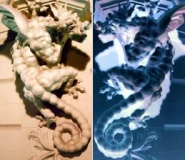Speaker
Dr
Miguel Nebot
(INFN - Roma Tre)
Description
In the framework of a model with violation of $3\times 3$ unitarity we show that it is possible to accommodate the observed size of the phase in $B^0_s$--$\bar B^0_s$ mixing.
This $3\times 3$ unitarity mixing violation is associated to the presence of a new $Q=2/3$ isosinglet quark $T$ with a mass not exceeding 500 GeV.
The crucial point is the fact that this framework allows for $\chi\equiv\arg(-V_{ts}V_{cb}V_{tb}^*V_{cs}^*)$ of order $\lambda$, to be contrasted with the situation in the Standard Model, where $\chi$ is constrained to be of order $\lambda^2$.
This scenario implies rare top decays $t\to cZ$ at a rate observable at the LHC and $|V_{tb}|$ significantly different from unity. Additionally one may also account for the observed size of $D^0$--$\bar D^0$ mixing without having to invoke long distance contributions. It is also shown that the observed size of $D^0$--$\bar D^0$ mixing constrains $\chi^\prime\equiv\arg(-V_{cd}V_{us}V_{cs}^*V_{ud}^*)$ to be of order $\lambda^4$, which is significantly smaller than what is allowed in generic models with violations of $3\times 3$ unitarity.
Authors
Prof.
Francisco J. Botella
(University of Valencia - IFIC)
Prof.
Gustavo Branco
(CFTP - IST Lisbon)
Dr
Miguel Nebot
(INFN - Roma Tre)
